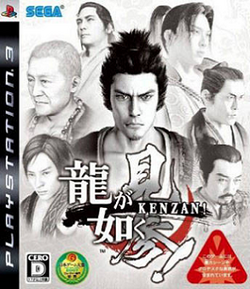Software:Ryū ga Gotoku Kenzan!
| Ryū ga Gotoku Kenzan! | |
|---|---|
 Box art | |
| Developer(s) | Sega NE R&D |
| Publisher(s) | Sega |
| Director(s) | Daisuke Sato |
| Producer(s) | Masayoshi Kikuchi |
| Artist(s) | Kazuki Hosokawa |
| Writer(s) | Masayoshi Yokoyama |
| Composer(s) |
|
| Series | Like a Dragon |
| Platform(s) | PlayStation 3 |
| Release | |
| Genre(s) | Action-adventure, hack and slash, beat 'em up |
| Mode(s) | Single-player |
Ryu ga Gotoku Kenzan![lower-alpha 1] [2] is an action-adventure video game developed and published by Sega for the PlayStation 3.[3] It is a jidaigeki-themed spin-off game in the Like a Dragon series. It was unveiled at the Tokyo Game Show 2007[4] and released in 2008.
A second Like a Dragon series spin-off set in samurai era, Ryū ga Gotoku Ishin!, was released in 2014 on both the PlayStation 3 and the PlayStation 4 systems. Ishin! is set two centuries later than Kenzan!, hence the plots are not related to each other since both games focus on different characters, the historical figures of Sakamoto Ryōma (1836–1867) and Miyamoto Musashi (1584–1645) respectively.
Development
After successfully releasing the first two games on the PlayStation 2, the team initially made fun of their goal of making the next game for the then-new PlayStation 3, while also moving to a different setting. However, they managed to make it in just a year and a bit, and the staff felt refreshed.[5][6]
Gameplay
Adventure
The gameplay shows minimal evolution from the first two episodes except for the new item storage system which allows access to an unlimited number of items from savepoints.[7]
Battle
There are four fighting styles in the game; fists, one blade, two blades and two-handed blades. There are also QTE-based special moves that the player can execute, known as 'heat action'.[7]
Plot
Setting
This spin-off is set in Kyoto during the Edo period, in 1605. It is an account of the life of Miyamoto Musashi. The main adventure is completed with sidestories including minigames and a hundred "sub-stories".[8]
Story
After being defeated by the Tokugawa clan at the historical Battle of Sekigahara which took place on October 21, 1600, Miyamoto Musashi retired from his great swordsman life to become a modest yojimbo (bodyguard) in Gion (祇園), Kyoto. Five years after the battle, a little girl named Haruka comes to Gion seeking a local hitman known as Kazumanosuke Kiryu which is actually Miyamoto's new identity. After eventually finding Kiryū, Haruka asks for him to assassinate an impostor pretending to be Miyamoto Musashi. At first, Kiryu refuses, then when the girl goes as far as becoming an indentured servant in an opulent oiran brothel in order to pay the assassination mission he accepts the one-ryō request.
Characters
This is the first game in the series where the games' main characters have their face modeled in 3D after their voice actors who are Japanese celebrities.[9] Cyberware's color 3D scanner (model PS)[10] was used to analyze each actor's head & face in order to collect data on its shape and appearance, then this file was worked with the Softimage XSI 3D graphics application.
- Takaya Kuroda as Kazumanosuke Kiryu (桐生 一馬之介) / Miyamoto Musashi (宮本 武蔵)
- Shota Matsuda as Sasaki Kojirō (佐々木 小次郎)
- Susumu Terajima as Itō Ittōsai (伊東 一刀斎)
- Masaya Kato as Seijuro Yoshioka (吉岡 清十郎)
- Takashi Tsukamoto as Gion Tōji (祗園 藤次)
- Hiroki Matsukata as Mysterious Monk (謎の僧)
- Naoto Takenaka as Marume Nagayoshi (丸目 長恵)
- Aya Hisakawa as Yoshino Tayū (吉野 太夫)
- Rie Kugimiya as Haruka (遥)
- Yinling of Joytoy as Libido Waterfall (滝の煩悩)
Releases
Trial versions
Two playable demos were released on January 7, 2008, via the Japanese PlayStation Store. The first demo included sandbox play, and the second had a collection of various combat and romantic gameplay segments.[11]
As part of the pre-ordering campaign, the Japanese first print was bundled with a limited item, a monography called Kamutai Magazine (March 2008 issue). Sony celebrated the Japanese release of the game with a 10,000 pieces limited edition Satin Silver 40GB model "PlayStation 3 Ryū ga Gotoku Kenzan! Pack" (PlayStation®3 龍が如く 見参!パック Ryū Ga Gotoku Kenzan! Pakku) SKU including a "Rising Dragon" (昇竜 Noburyū) stickers set to customize the console case.[12]
Asian and western markets
The Japanese version was released on March 6, 2008, in both Japan[8] and South East Asia,[13] while Sony published it in South Korea on March 25, 2008, with a subtitled script book.[14]
In late December 2009, commenting the opportunity of a western release, Sega Australia managing director Darren Macbeth said "there is nothing in the plan at this stage for Yakuza Kenzan. Right now we are focusing on the release of Yakuza 3. The feedback we get from this release will help us in making future decisions".[2] In March 2010, Yakuza 3 had a western release as did in 2011 Yakuza 4. Then again, in 2012, a second spinoff was also released abroad and localized as Yakuza.
In 2019, then-producer of the series, Daisuke Sato, commented that due to its age as an early PS3 game, releasing a simple HD remaster as with Yakuza 3-5 (which were re-released as The Yakuza Remastered Collection) would make players today feel like something is missing, and as a result, Kenzan! is suitable for a remake similar to Yakuza Kiwami and Yakuza Kiwami 2.[15]
Though a Western release has yet to happen, the Western release of Like a Dragon in 2023 (originally released in Japan in 2014) has led to an increased speculation about a Western release of Kenzan!
Soundtrack
The Ryu Ga Gotoku Kenzan! Original Sound Track (HCV-381) album was published by Wave Master in Japan on March 6, 2008.[16] The music was composed by Hidenori Shoji, Hideki Sakamoto, Hiroyoshi Kato, Keisuke Ito and Yuri Fukuda, with additional cutscene music by Hideki Naganuma.[17]
The game also features two songs by Japanese hip hop artists Zeebra and Ketsumeishi; Zeebra collaborated later with the Yakuza 4 opening theme, "Butterfly City".
- opening theme: Bushido by Zeebra. Released in Japan by Pony Canyon (PCCA-02642) as a dual-disc single on March 5, 2008. First disc is a CD including the title track and an instrumental version plus a B-side Lyrical Gunman (Three Gunz Up Remix) featuring Rudebwoy Face and Chappa Ranks. Second disc is a bonus DVD with the music video for Bushido which includes cutscene footages from the game.[18]
- closing theme: Life is Beautiful (ライフイズビューティフル Raifu Izu Byutifuru) by Ketsumeishi from their 2007 album Ketsupolis 5 published in Japan by Toy's Factory.
Marketing
Licensed products
Clothes manufacturer Cropped Heads collaborated with Sega to produce licensed Ryu Ga Gotoku Kenzan! tee-shirts,[19] and Ace Cook produced Ryu Ga Gotoku Kenzan! cup noodles.[20]
Reception
Within four days of its release in Japan, Ryū ga Gotoku Kenzan! sold 177,897 copies.[21] As of March 31, 2008, it sold 282,800 copies.[22] As a best seller in Japan, the game received a budget re-release under the PlayStation 3 the Best bargain collection on December 11, 2008.[23] It reached lifetime sales of 387,148 in Japan.[21]
It earned the Award for Excellence at the Japan Game Awards 2008,[24] and the Japanese video game magazine Famitsu reviewed it 37/40.[25]
Notes
References
- ↑ Ryu ga Gotoku Kenzan! @ GameSpot
- ↑ 2.0 2.1 Parker, Laura (2009-12-28). "Nagoshi talks Yakuza 3". http://www.gamespot.com/pages/gamespace/updates.php?pid=950186&sid=6243556&skipmc=1&mode=previews.
- ↑ Miller, Greg (2007-09-12). "Yakuza 3 a PS3 Exclusive" (in en). https://www.ign.com/articles/2007/09/12/yakuza-3-a-ps3-exclusive.
- ↑ "PLAYSTATION®3 出展タイトル|東京ゲームショウ2007特設サイト" (in ja-JP). http://www.jp.playstation.com/tgs2007/ps3/titles/sega_ryu.html.
- ↑ Famitsu. https://www.famitsu.com/news/201009/01032926.html.
- ↑ "Ryu encyclopaedia". http://fftranslations.atspace.co.uk/rtz/nagoshi.html.
- ↑ 7.0 7.1 Famitsu Article [unreliable source?]
- ↑ 8.0 8.1 "PlayStation.com(Japan)|ソフトウェアカタログ|龍が如く 見参!" (in ja-JP). http://www.jp.playstation.com/software/title/bljm60064.html.
- ↑ 福田柵太郎 (2007-12-04). "セガ、PS3「龍が如く 見参!」完成披露会を開催発売日が2008年3月6日に決定". Game Watch. http://game.watch.impress.co.jp/docs/20071204/ryu.htm.
- ↑ "HP Workstation 導入事例紹介株式会社セガ 「龍が如く3」". Hewlett-Packard. 2009. http://h50146.www5.hp.com/products/workstations/personal_ws/case_studies/sega_ryugagotoku.html.
- ↑ Crecente, Brian (2008-01-07). "Yakuza 3 Demo Hits Japan's PSN". http://kotaku.com/341754/yakuza-3-demo-hits-japans-psn.
- ↑ "『龍が如く 見参!』と新色サテン・シルバーのプレイステーション3本体を同梱した特別パックが発売". Famitsu. 2008-02-05. http://www.famitsu.com/game/news/1213425_1124.html.
- ↑ "Ryu ga Gotoku Kenzan! for PlayStation 3™ (PS3™)". http://www.play-asia.com/ryu-ga-gotoku-kenzan/13/702gfq.
- ↑ "용과 같이 켄잔!" (in ko). http://www.playstation.co.kr/ps_game/gam_main_view.sce?sid=1206&iPage=8.
- ↑ Wong, Alistair (2019-06-24). "Yakuza Producer Says That Yakuza: Kenzan Could Get A Kiwami Version" (in en-US). https://www.siliconera.com/yakuza-producer-says-that-yakuza-kenzan-could-get-a-kiwami-version/.
- ↑ "ソフトと同時に見参! 『「龍が如く 見参!」オリジナルサウンドトラック』が発売決定 - ファミ通.com" (in ja). Famitsu. 2008-01-25. https://www.famitsu.com/game/news/1213199_1124.html. Retrieved 2023-03-05.
- ↑ @Hideki_Naganuma (2012-07-20). "@JetGrindSA Just a few songs for movie scene on "Ryu Ga Gotoku Kenzan!" But those were not JSR style music.". https://twitter.com/Hideki_Naganuma/status/226175167066431489.
- ↑ "ZEEBRA - BUSHIDO". https://www.youtube.com/watch?v=wh1tTdxCw1k.
- ↑ "Tシャツ : CROPPEDHEADS セガ コラボTee「龍が如く見参」 復刻版 : クロップドヘッズ". Repair Co.. 2008. http://www.repair-co.jp/shop/goods/1643/.
- ↑ "焼きうどん「龍が如く」見参!". IT Media. 2008-01-17. http://www.itmedia.co.jp/news/articles/0801/17/news115.html.
- ↑ 21.0 21.1 "Game Search". Game Data Library (Famitsu sales data). https://sites.google.com/site/gamedatalibrary/game-search. Retrieved March 28, 2023.
- ↑ "FY 2008 FY 2008 Full Year Results Full Year Results". Sega Sammy Holdings. May 15, 2008. p. 16. https://www.segasammy.co.jp/english/ir/library/pdf/settlement/2008/e_200803_4q_pre.pdf.
- ↑ "PlayStation®3 the Best" (in ja-JP). http://www.jp.playstation.com/ps3/ps3thebest/2008.html.
- ↑ "Japan Game Awards 2008 – Games of the Year Division". CESA Awards. 2008. http://awards.cesa.or.jp/2008/english/award/year_09.html.
- ↑ onAxis article [unreliable source?]
External links
 |




